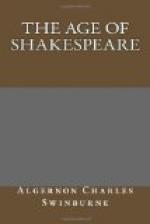It was many a year before Dick Pike had earned the honor of commemoration by his hand or by any other poet’s that Heywood had won his spurs as the champion presenter—if I may be allowed to revive the word—of his humbler and homelier countrymen under the light of a no less noble than simple realism. “The Fair Maid of the Exchange” is a notable example of what I believe is professionally or theatrically called a one-part piece. Adapting Dr. Johnson’s curiously unjust and inept remark on Shakespeare’s “King Henry VIII.”—the play in which, according to the principles or tenets of the new criticism which walks or staggers by the new light of a new scholarship, “the new Shakspere” may or must have been assisted by Flitcher (why not also by Meddletun, Messenger, and a few other novi homines?), we may say, and it may be said this time with some show of reason, that the genius of the author limps in and limps out with the Cripple. Most of the other characters and various episodical incidents of the incomposite story are alike, if I may revive a good and expressive phrase of the period, hastily and unskilfully slubbered up: Bowdler is a poor second-hand and third-rate example of the Jonsonian gull; and the transfer of Moll’s regard from him to his friend is both childishly conceived and childishly contrived. On the whole, a second-rate play, with one or two first-rate scenes and passages to which Lamb has done perhaps no more than justice by the characteristic and eloquent cordiality of his commendations. Its date may be probably determined as early among the earliest of its author’s by the occurrence in mid-dialogue of a sestet in the popular metre of “Venus and Adonis,” with archaic inequality in the lengths of the second and fourth rhyming words: a notable note of metrical or immetrical antiquity in style. The self-willed if high-minded Phyllis Flower has something in her of Heywood’s later heroines, Bess Bridges of Plymouth and Luce the goldsmith’s daughter, but is hardly as interesting or attractive as either.
Much less than this can be said for the heroines, if heroines they can in any sense be called, of the two plays by which Heywood is best known as a tragic and a comic painter of contemporary life among his countrymen. It is certainly not owing to any exceptional power of painting or happiness in handling feminine character that the first place among his surviving works has been generally and rationally assigned to “A Woman Killed with Kindness.” The fame of this famous realistic tragedy is due to the perfect fitness of the main subject for treatment in the manner of which Heywood was in his day and remains to the present day beyond all comparison the greatest and the most admirable master. It is not that the interest is either naturally greater, or greater by force and felicity of genius in the dramatist, than that of other and far inferior plays. It is not that the action is more artistically managed: it is not that curiosity or sympathy is aroused or




